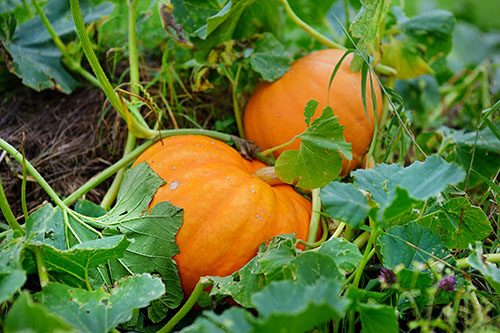Tips for Growing Your Own Pumpkins
Oct 04, 2022

Every October, pumpkins take center stage as a symbol of the arrival of fall. They are a favored decoration through Thanksgiving, and their popularity peaks around Halloween as families visit pumpkin patches to find the perfect carving pumpkin.
Pumpkins have so much more to offer, though — just look at their bold, orange color. Like carrots, pumpkins get their color from carotenoids, which are a rich source of vitamin A. They also contain B vitamins, vitamin C, minerals, fiber, and beta-carotene, which help the body fight disease.
Now that you know some of the benefits of pumpkins, have you ever thought about growing your own? Whether you want large, round pumpkins for your jack-o’-lanterns, white pumpkins for decorating, or sweet pumpkins for pie, keep reading for tips on how to grow pumpkins in the spring.
Growing
A successful harvest begins with the right growing conditions. Pumpkins like full sun and loose, well-drained soil that has an acidity of 6.0 to 6.8 pH. Contact your local Co-op for soil testing and recommendations on amendments. When planning your garden, designate enough space to accommodate pumpkins’ sprawling nature. If you have limited space, there are several bush varieties to consider, which have restricted vining. Determine how you will use your pumpkins and purchase seeds accordingly. Pumpkins for jack-o’-lanterns will likely have bland, stringy flesh, while pie pumpkins typically have a smaller, sweeter fruit.
Planting
For a late-September or early-October harvest, you will typically want to plant around mid- to late-June. Because different pumpkin varieties vary, though, follow the maturity date on the seed packet for the most accurate results. Pile up the soil into slightly raised hills and plant the pumpkin seeds one inch deep. Plant four to five seeds per mound, and as they begin to grow into seedlings, thin them down to the healthiest two or three plants per mound. Mulch around the plants to stifle weed growth but avoid using a garden hoe as pumpkins’ roots grows close to the soil’s surface. Water the seeds lightly and frequently until the plants become established. As the fruit begins to grow, continue irrigation regularly, providing a thorough soaking rather than light applications.
Harvesting
Harvest your pumpkins before the first heavy frost once they have developed their full size and color. Use pruning shears to cut the fruit from the vine, leaving at least three inches of stem. Allow them to harden in dry, sunny weather for about two weeks and then store in a cool, dry place, around 50 to 55 degrees Fahrenheit. Washing your pumpkins with a weak bleach solution will help to reduce mold and decay but remember to wash the bleach residue off with water before storing them.
No matter what you are wanting to grow in your vegetable garden next year, local Co-op has all the necessary supplies, including expert advice to help you through the process. We can’t wait to see your harvest next year!
For more content like this, check out the latest issue of The Cooperator.
Pumpkins have so much more to offer, though — just look at their bold, orange color. Like carrots, pumpkins get their color from carotenoids, which are a rich source of vitamin A. They also contain B vitamins, vitamin C, minerals, fiber, and beta-carotene, which help the body fight disease.
Now that you know some of the benefits of pumpkins, have you ever thought about growing your own? Whether you want large, round pumpkins for your jack-o’-lanterns, white pumpkins for decorating, or sweet pumpkins for pie, keep reading for tips on how to grow pumpkins in the spring.
Growing
A successful harvest begins with the right growing conditions. Pumpkins like full sun and loose, well-drained soil that has an acidity of 6.0 to 6.8 pH. Contact your local Co-op for soil testing and recommendations on amendments. When planning your garden, designate enough space to accommodate pumpkins’ sprawling nature. If you have limited space, there are several bush varieties to consider, which have restricted vining. Determine how you will use your pumpkins and purchase seeds accordingly. Pumpkins for jack-o’-lanterns will likely have bland, stringy flesh, while pie pumpkins typically have a smaller, sweeter fruit.
Planting
For a late-September or early-October harvest, you will typically want to plant around mid- to late-June. Because different pumpkin varieties vary, though, follow the maturity date on the seed packet for the most accurate results. Pile up the soil into slightly raised hills and plant the pumpkin seeds one inch deep. Plant four to five seeds per mound, and as they begin to grow into seedlings, thin them down to the healthiest two or three plants per mound. Mulch around the plants to stifle weed growth but avoid using a garden hoe as pumpkins’ roots grows close to the soil’s surface. Water the seeds lightly and frequently until the plants become established. As the fruit begins to grow, continue irrigation regularly, providing a thorough soaking rather than light applications.
Harvesting
Harvest your pumpkins before the first heavy frost once they have developed their full size and color. Use pruning shears to cut the fruit from the vine, leaving at least three inches of stem. Allow them to harden in dry, sunny weather for about two weeks and then store in a cool, dry place, around 50 to 55 degrees Fahrenheit. Washing your pumpkins with a weak bleach solution will help to reduce mold and decay but remember to wash the bleach residue off with water before storing them.
No matter what you are wanting to grow in your vegetable garden next year, local Co-op has all the necessary supplies, including expert advice to help you through the process. We can’t wait to see your harvest next year!
For more content like this, check out the latest issue of The Cooperator.